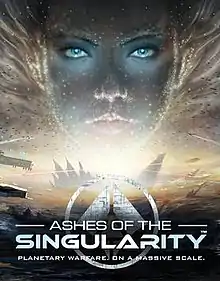Ashes of the Singularity
Ashes of the Singularity is a real-time strategy video game developed by Oxide Games and Stardock Entertainment. The game was released for Microsoft Windows on March 31, 2016. The game features massive battles involving thousands of units on vast battlefields. As such, it requires relatively high-end hardware. A standalone expansion pack, called Ashes of the Singularity: Escalation was released in November 2016, but was later merged into the main game.
| Ashes of the Singularity | |
|---|---|
 | |
| Developer(s) | |
| Publisher(s) | Stardock Entertainment |
| Composer(s) |
|
| Engine | Nitrous Engine |
| Platform(s) | Microsoft Windows |
| Release | March 31, 2016 |
| Genre(s) | Real-time strategy |
| Mode(s) | Single-player, multiplayer |
Gameplay
Ashes of the Singularity is a real-time strategy video game, featuring two primary factions: the Post-Human Coalition and the Substrate.[1] Its main distinction is its ability to handle thousands of individual units engaging in combat simultaneously, far greater than most other games of its kind, across large maps and without abstraction. This is achieved through a newly developed engine called Nitrous designed to fully leverage modern 64-bit multi-core processors, reflected in the relatively high system requirements (which include a quad-core processor). To allow players to effectively control such large numbers of units, groups of individual units can be combined into "meta-units" which operate in a cohesive manner, upon which complex strategies can be developed.[2]
Development
Ashes of the Singularity is powered by Oxide Games' in-house Nitrous Engine,[3] and was the first video game to implement DirectX 12 support.[4] It is also one of the first to support Vulkan.[5] An in-development version of the game was released commercially via Steam Early Access on October 22, 2015.[1] The full version of the game was released on Windows on March 31, 2016.[6]
Because of the game's early DirectX 12 support and extensive use of parallel computation, it is commonly used as a benchmark. Controversy erupted when Nvidia GPUs were found to perform poorly relative to their AMD counterparts on early beta versions of Ashes;[7][8] this was due to the game's use of asynchronous compute and shading features which are implemented in hardware on AMD Graphics Core Next GPUs but had to be performed in software on Nvidia GPUs.[9]
On November 10, 2016, Ashes of the Singularity: Escalation was released. It is a standalone expansion that adds to the base game with more units, maps, and structures, as well as several interface tweaks. The total player count was also increased from 8 to 16 players. The expansion was later merged into the base game on February 16, 2017, after it became apparent that the separate games divided the player community.[10]
Stardock have been working on a linux-native client for some time. While no promise of a release date as of yet, there was hope it would be made available in 2019. [11]
Reception
| Aggregator | Score |
|---|---|
| Metacritic | 69/100[12] (Escalation) 81/100[13] |
| Publication | Score |
|---|---|
| Game Informer | 6.75/10[14] |
| GameSpot | 4/10[15] |
| IGN | 7.7/10[16] (Escalation) 8.1/10[17] |
| PC Gamer (US) | 75/100[18] |
| PCGamesN | 9/10[19] |
Ashes of the Singularity received an "average" reception from critics according to aggregate review website Metacritic.[12]
Giving it a good score of 7.7, IGN wrote: "This is a warzone where the shrewd general looking at the bigger picture will triumph over the fast-thinking ace with lightning hotkeys."[20]
PC Gamer gave it a score of 75/100.[21] GameSpot gave it a mixed review.[22]
References
- Sykes, Tom (October 15, 2015). "Ashes of the Singularity hitting Early Access next week". PC Gamer. Retrieved January 8, 2016.
- Oxide Games. "Ashes of the Singularity FAQ". Retrieved 24 February 2017.
- "FAQ: Ashes of the Singularity". Retrieved July 7, 2022.
- Hillier, Brenna (October 23, 2015). "Stardock launches first ever DirectX 12 game". VG247. Retrieved January 8, 2016.
- Takahashi, Dean (March 1, 2016). "How Ashes of the Singularity enables massive planetary battles with huge sci-fi armies". GamesBeat. VentureBeat. Retrieved July 6, 2016.
- Chalk, Andy (March 9, 2016). "Ashes of the Singularity release date revealed in new trailer". PC Gamer. Future plc. Retrieved August 3, 2016.
- Mah Ung, Gordon (17 August 2015). "Windows 10's DirectX 12 graphics performance tested: More CPU cores, more oomph". PCWorld. Retrieved 24 February 2017.
- Dingman, Hayden (22 October 2015). "Ashes of the Singularity hits Steam, letting you benchmark DirectX 12 at home". PCWorld. Retrieved 24 February 2017.
- Wallossek, Igor (29 February 2016). "Ashes Of The Singularity Beta: Async Compute, Multi-Adapter & Power". Tom's Hardware. Retrieved 24 February 2017.
- Wardell, Brad. "ONE COMMUNITY: Merging the Singularity". Stardock. Retrieved 24 February 2017.
- "Linux Request sign up sheet :: Ashes of the Singularity: Escalation General Discussions". steamcommunity.com. Retrieved 2019-01-06.
- "Ashes of the Singularity for PC Reviews". Metacritic. CBS Interactive. Retrieved August 3, 2016.
- "Ashes of the Singularity: Escalation for PC Reviews". Metacritic. CBS Interactive. Retrieved May 8, 2020.
- Tack, Daniel (12 April 2016). "Ashes of the Singularity Review - Formulaic and Forgettable". Game Informer. Retrieved 2 October 2021.
- Starkey, Daniel (25 April 2016). "Ashes of the Singularity Review". GameSpot. Retrieved 2 October 2021.
- Hafer, TJ (31 March 2016). "Ashes of the Singularity Review". IGN. Retrieved 2 October 2021.
- Hafer, TJ (10 November 2016). "Ashes of the Singularity Review". IGN. Retrieved 2 October 2021.
- Johnson, Leif (1 April 2016). "Ashes of the Singularity review". PC Gamer. Retrieved 2 October 2021.
- Donnelly, Joe (31 March 2016). "Ashes of the Singularity review". PCGamesN. Retrieved 2 October 2021.
- Hafer, TJ (March 31, 2016), ASHES OF THE SINGULARITY REVIEW, retrieved January 8, 2017
- Johnson, Leif (April 1, 2016), ASHES OF THE SINGULARITY REVIEW, PCGamer, retrieved January 8, 2017
- Starkey, Daniel (April 25, 2016), Ashes of the Singularity Review, GameSpot, retrieved January 8, 2017